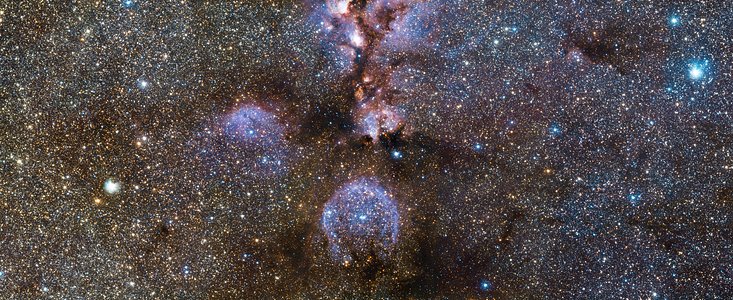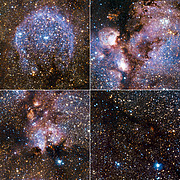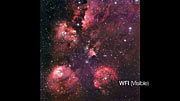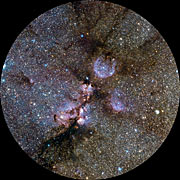Komunikat prasowy
VISTA Captures Celestial Cat’s Hidden Secrets
21 kwietnia 2010

Acknowledgment: Cambridge Astronomical Survey Unit)
The Cat’s Paw Nebula, NGC 6334, is a huge stellar nursery, the birthplace of hundreds of massive stars. In a magnificent new ESO image taken with the Visible and Infrared Survey Telescope for Astronomy (VISTA) at the Paranal Observatory in Chile, the glowing gas and dust clouds obscuring the view are penetrated by infrared light and some of the Cat’s hidden young stars are revealed.
Towards the heart of the Milky Way, 5500 light-years from Earth in the constellation of Scorpius (the Scorpion), the Cat’s Paw Nebula stretches across 50 light-years. In visible light, gas and dust are illuminated by hot young stars, creating strange reddish shapes that give the object its nickname. A recent image by ESO’s Wide Field Imager (WFI) at the La Silla Observatory (eso1003) captured this visible light view in great detail. NGC 6334 is one of the most active nurseries of massive stars in our galaxy.
VISTA, the latest addition to ESO’s Paranal Observatory in the Chilean Atacama Desert, is the world’s largest survey telescope (eso0949). It works at infrared wavelengths, seeing right through much of the dust that is such a beautiful but distracting aspect of the nebula, and revealing objects hidden from the sight of visible light telescopes. Visible light tends to be scattered and absorbed by interstellar dust, but the dust is nearly transparent to infrared light.
VISTA has a main mirror that is 4.1 metres across and it is equipped with the largest infrared camera on any telescope. It shares the spectacular viewing conditions with ESO’s Very Large Telescope (VLT), which is located on the nearby summit. With this powerful instrument at their command, astronomers were keen to see the birth pains of the big young stars in the Cat’s Paw Nebula, some nearly ten times the mass of the Sun. The view in the infrared is strikingly different from that in visible light. With the dust obscuring the view far less, they can learn much more about how these stars form and develop in their first few million years of life. VISTA’s very wide field of view allows the whole star-forming region to be imaged in one shot with much greater clarity than ever before.
The VISTA image is filled with countless stars of our Milky Way galaxy overlaid with spectacular tendrils of dark dust that are seen here fully for the first time. The dust is sufficiently thick in places to block even the near-infrared radiation to which VISTA’s camera is sensitive. In many of the dusty areas, such as those close to the centre of the picture, features that appear orange are apparent — evidence of otherwise hidden active young stars and their accompanying jets. Further out though, slightly older stars are laid bare to VISTA’s vision, revealing the processes taking them from their first nuclear fusion along the unsteady path of the first few million years of their lives.
The VISTA telescope is now embarking on several big surveys of the southern sky that will take years to complete. The telescope’s large mirror, high quality images, sensitive camera and huge field of view make it by far the most powerful infrared survey telescope on Earth. As this striking image shows, VISTA will keep astronomers busy analysing data they could not have otherwise acquired. This cat is out of the bag.
Więcej informacji
ESO, the European Southern Observatory, is the foremost intergovernmental astronomy organisation in Europe and the world’s most productive astronomical observatory. It is supported by 14 countries: Austria, Belgium, Czechia, Denmark, France, Finland, Germany, Italy, the Netherlands, Portugal, Spain, Sweden, Switzerland and the United Kingdom. ESO carries out an ambitious programme focused on the design, construction and operation of powerful ground-based observing facilities enabling astronomers to make important scientific discoveries. ESO also plays a leading role in promoting and organising cooperation in astronomical research. ESO operates three unique world-class observing sites in Chile: La Silla, Paranal and Chajnantor. At Paranal, ESO operates the Very Large Telescope, the world’s most advanced visible-light astronomical observatory and VISTA, the world’s largest survey telescope. ESO is the European partner of a revolutionary astronomical telescope ALMA, the largest astronomical project in existence. ESO is currently planning a 42-metre European Extremely Large optical/near-infrared Telescope, the E-ELT, which will become “the world’s biggest eye on the sky”.
Linki
- More about VISTA: http://www.eso.org/public/teles-instr/surveytelescopes/vista/
Kontakt
Richard Hook
Survey Telescopes PIO
Garching, Germany
Tel.: +49 89 3200 6655
E-mail: rhook@eso.org
O komunikacie
| Komunikat nr: | eso1017 |
| Nazwa: | Cat's Paw Nebula, NGC 6334 |
| Typ: | Milky Way : Nebula : Type : Star Formation |
| Facility: | Visible and Infrared Survey Telescope for Astronomy |
| Instrumenty: | VIRCAM |
Our use of Cookies
We use cookies that are essential for accessing our websites and using our services. We also use cookies to analyse, measure and improve our websites’ performance, to enable content sharing via social media and to display media content hosted on third-party platforms.
ESO Cookies Policy
The European Organisation for Astronomical Research in the Southern Hemisphere (ESO) is the pre-eminent intergovernmental science and technology organisation in astronomy. It carries out an ambitious programme focused on the design, construction and operation of powerful ground-based observing facilities for astronomy.
This Cookies Policy is intended to provide clarity by outlining the cookies used on the ESO public websites, their functions, the options you have for controlling them, and the ways you can contact us for additional details.
What are cookies?
Cookies are small pieces of data stored on your device by websites you visit. They serve various purposes, such as remembering login credentials and preferences and enhance your browsing experience.
Categories of cookies we use
Essential cookies (always active): These cookies are strictly necessary for the proper functioning of our website. Without these cookies, the website cannot operate correctly, and certain services, such as logging in or accessing secure areas, may not be available; because they are essential for the website’s operation, they cannot be disabled.
Functional Cookies: These cookies enhance your browsing experience by enabling additional features and personalization, such as remembering your preferences and settings. While not strictly necessary for the website to function, they improve usability and convenience; these cookies are only placed if you provide your consent.
Analytics cookies: These cookies collect information about how visitors interact with our website, such as which pages are visited most often and how users navigate the site. This data helps us improve website performance, optimize content, and enhance the user experience; these cookies are only placed if you provide your consent. We use the following analytics cookies.
Matomo Cookies:
This website uses Matomo (formerly Piwik), an open source software which enables the statistical analysis of website visits. Matomo uses cookies (text files) which are saved on your computer and which allow us to analyze how you use our website. The website user information generated by the cookies will only be saved on the servers of our IT Department. We use this information to analyze www.eso.org visits and to prepare reports on website activities. These data will not be disclosed to third parties.
On behalf of ESO, Matomo will use this information for the purpose of evaluating your use of the website, compiling reports on website activity and providing other services relating to website activity and internet usage.
Matomo cookies settings:
Additional Third-party cookies on ESO websites: some of our pages display content from external providers, e.g. YouTube.
Such third-party services are outside of ESO control and may, at any time, change their terms of service, use of cookies, etc.
YouTube: Some videos on the ESO website are embedded from ESO’s official YouTube channel. We have enabled YouTube’s privacy-enhanced mode, meaning that no cookies are set unless the user actively clicks on the video to play it. Additionally, in this mode, YouTube does not store any personally identifiable cookie data for embedded video playbacks. For more details, please refer to YouTube’s embedding videos information page.
Cookies can also be classified based on the following elements.
Regarding the domain, there are:
- First-party cookies, set by the website you are currently visiting. They are stored by the same domain that you are browsing and are used to enhance your experience on that site;
- Third-party cookies, set by a domain other than the one you are currently visiting.
As for their duration, cookies can be:
- Browser-session cookies, which are deleted when the user closes the browser;
- Stored cookies, which stay on the user's device for a predetermined period of time.
How to manage cookies
Cookie settings: You can modify your cookie choices for the ESO webpages at any time by clicking on the link Cookie settings at the bottom of any page.
In your browser: If you wish to delete cookies or instruct your browser to delete or block cookies by default, please visit the help pages of your browser:
Please be aware that if you delete or decline cookies, certain functionalities of our website may be not be available and your browsing experience may be affected.
You can set most browsers to prevent any cookies being placed on your device, but you may then have to manually adjust some preferences every time you visit a site/page. And some services and functionalities may not work properly at all (e.g. profile logging-in, shop check out).
Updates to the ESO Cookies Policy
The ESO Cookies Policy may be subject to future updates, which will be made available on this page.
Additional information
For any queries related to cookies, please contact: pdprATesoDOTorg.
As ESO public webpages are managed by our Department of Communication, your questions will be dealt with the support of the said Department.






